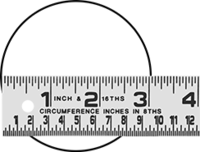You are using an out of date browser. It may not display this or other websites correctly.
You should upgrade or use an alternative browser.
You should upgrade or use an alternative browser.
Irrational Lengths
- Thread starter yalialp06
- Start date
Steven G
Elite Member
- Joined
- Dec 30, 2014
- Messages
- 14,559
Check out this video I made a while ago. It shows that the square root of any positive integer is constructible. Click here
D
Deleted member 4993
Guest
Why do you think that length cannot be irrational?We often say that the length of the hypotenuse is square root of 2 or the square root of 5. How can a length be irrational?
The circumference of a circle - which is a "length" - is also irrational.
Steven G
Elite Member
- Joined
- Dec 30, 2014
- Messages
- 14,559
Not always! Corner time for you!Why do you think that length cannot be irrational?
The circumference of a circle - which is a "length" - is also irrational.
D
Deleted member 4993
Guest
Not always! Corner time for you!
You want to start with an irrational diameter (or radius)?
Steven G
Elite Member
- Joined
- Dec 30, 2014
- Messages
- 14,559
Yes, will that be a problem?You want to start with an irrational diameter (or radius)?
D
Deleted member 4993
Guest
Yes, will that be a problem?
Not for irrational people!
"Irrational" as a word might lead one to think that the number is preposterous or nonsensical, but it has an explicit and well-defined scientific meaning when used in a mathematical context. Irrationality simply means that the number cannot be expressed as a fraction of integers. It is, however, still an ordinary number otherwise.
I guess because we cant measure it.If you have a right triangle and the legs are both 1, then the hypotenuse is sqrt(2). Just ask Pythagoras. Why do you think that a length can't be sqrt(2)??
I know it can be irrational. I just don't know how to explain how it can be irrational. Meaning, how can there be a length that I can't measure.Why do you think that length cannot be irrational?
The circumference of a circle - which is a "length" - is also irrational.
T
This length which is finite is represented by a number that is infinite!I know it can be irrational. I just don't know how to explain how it can be irrational. Meaning, how can there be a length that I can't measure.
Steven G
Elite Member
- Joined
- Dec 30, 2014
- Messages
- 14,559
Come on you know that sqrt(2) is NOT infinite. Just because as a decimal number it goes on forever you can't conclude that sqrt(2) is infinite. After all you can write 1 as 1.000000.... and 1 is finite. sqrt(2) < 2 so how can it be infinite?
I can measure the sqrt(2)!! And I can do it with absolute precision! Again, what is the hypotenuse of a right triangle whose legs are both 1? Just put a straight edge along that hypotenuse, mark off the beginning and end of that hypotenuse and you have the length of sqrt(2).
Did you watch the video that I posted above? Please watch it.
I can measure the sqrt(2)!! And I can do it with absolute precision! Again, what is the hypotenuse of a right triangle whose legs are both 1? Just put a straight edge along that hypotenuse, mark off the beginning and end of that hypotenuse and you have the length of sqrt(2).
Did you watch the video that I posted above? Please watch it.
There is no such thing as a physically observable number that can be proven to be irrational. The irrational numbers exist in a Platonic world of ideas where such things as perfect triangles, dimensionless points, lines of infinite length, and errorless measurements exist. Clearly, that is not the world of physical reality. It is surprising how useful such idealized concepts are when applied to the real world.
Jomo. Your explanations are very helpful. Especially when you explained that the sqt of 2 is less than 2, therefore it cannot be infinite. I also liked how you explained that it being represented by a decimal that goes on forever does not mean it's infinite. Thank you for that. I also watched your video. I understand the construction somewhat, but I have to think about it more deeply. I also added a link to a document that I was reading as part of my exploration. It is below. The document explains the construction in your video. Thank you again, and I will continue to explore these ideas.
Attachments
Another way that I think it can be explained is with 1/3 for example. 1/3 when written as a decimal, repeats forever. That doesn't mean that 1/3 is an infinite number. It just means that 1/3 doesn't fit our number system of base 10, therefore the decimal repeats. These are just some ideas going on in my mind. Does anyone agree or want to add anything?
You can buy something called a circumference ruler that is placed along the diameter of a circle, but the markings on the ruler show the circumference instead. It's marked on a scale of [MATH]\pi[/MATH], rather than 1, meaning it can be used to measure not just an irrational number, but a transcendental number as well!


metastable
New member
- Joined
- Oct 18, 2020
- Messages
- 12
from a circle radius 1 we can obtain the irrational lengths sqrt(2), sqrt(3), sqrt(5), sqrt(6) etc...


